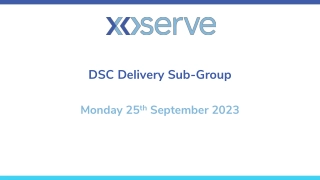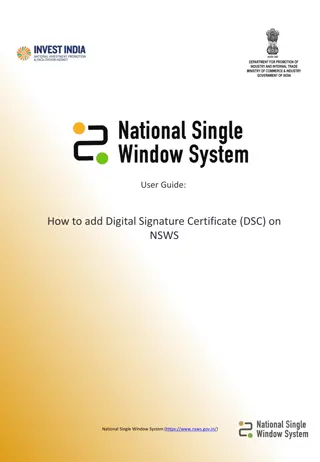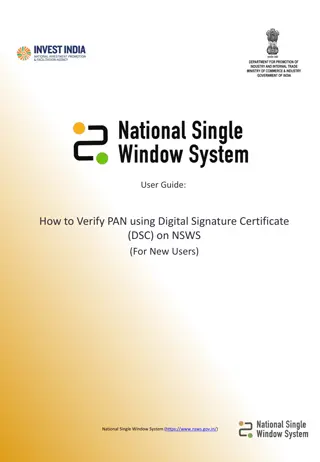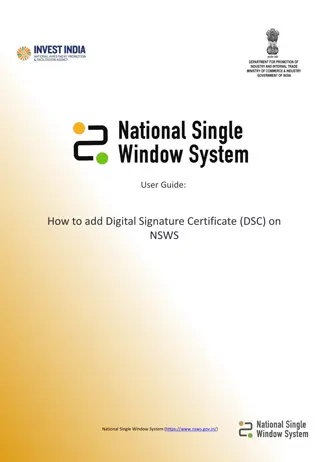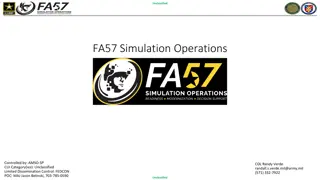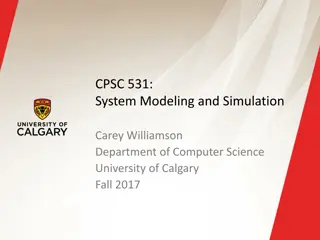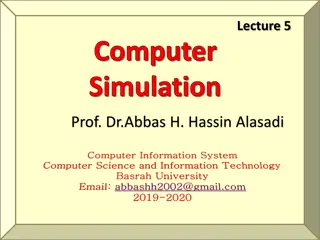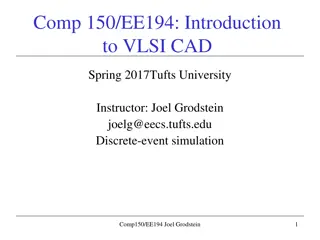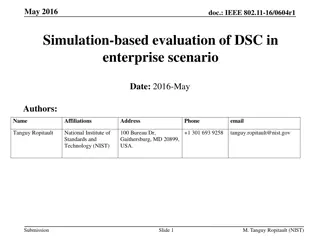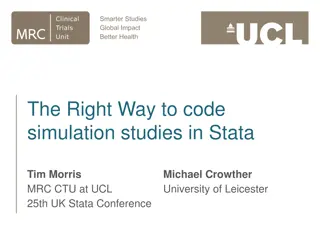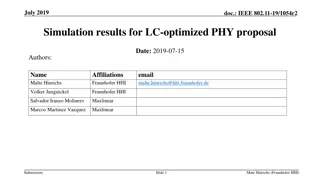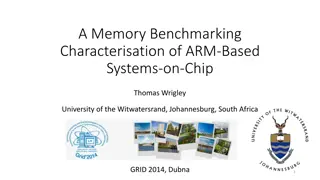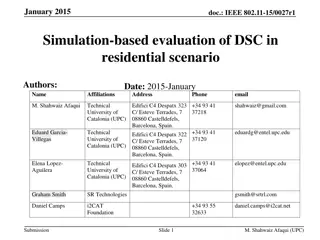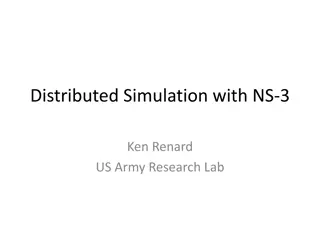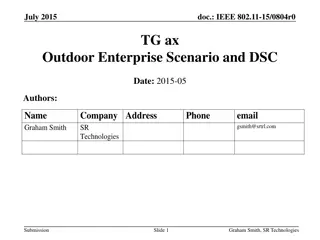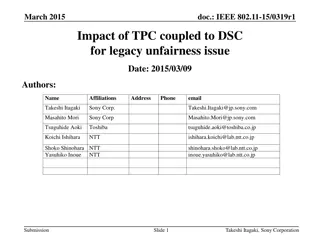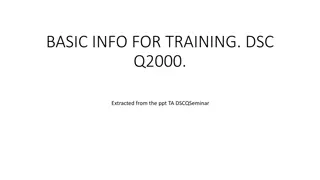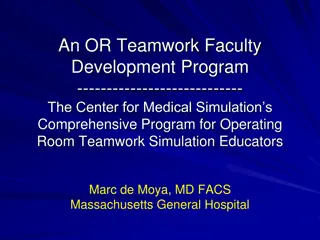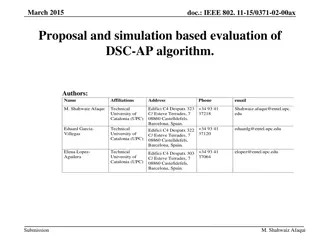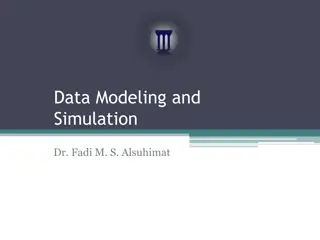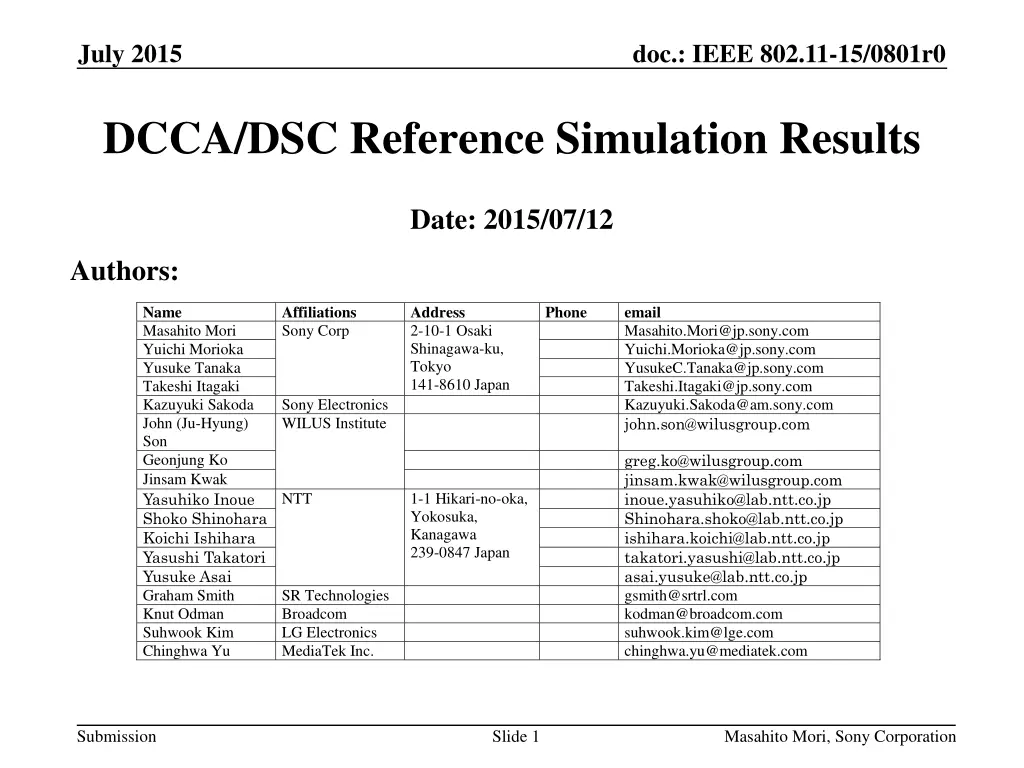
IEEE 802.11-15 DCCA/DSC Reference Simulation
Explore the results of a simulation study conducted in July 2015 by Masahito Mori and others from various affiliations like Sony, Nokia, and more. The study focuses on improving system throughput by adjusting CCA-SD thresholds and provides insights into practical scenarios for TGax Simulation. Detailed results and scenarios are outlined in the submission slides included in the document.
Download Presentation

Please find below an Image/Link to download the presentation.
The content on the website is provided AS IS for your information and personal use only. It may not be sold, licensed, or shared on other websites without obtaining consent from the author. If you encounter any issues during the download, it is possible that the publisher has removed the file from their server.
You are allowed to download the files provided on this website for personal or commercial use, subject to the condition that they are used lawfully. All files are the property of their respective owners.
The content on the website is provided AS IS for your information and personal use only. It may not be sold, licensed, or shared on other websites without obtaining consent from the author.
E N D
Presentation Transcript
July 2015 doc.: IEEE 802.11-15/0801r0 DCCA/DSC Reference Simulation Results Date: 2015/07/12 Authors: Name Masahito Mori Yuichi Morioka Yusuke Tanaka Takeshi Itagaki Kazuyuki Sakoda John (Ju-Hyung) Son Geonjung Ko Jinsam Kwak Yasuhiko Inoue Shoko Shinohara Koichi Ishihara Yasushi Takatori Yusuke Asai Graham Smith Knut Odman Suhwook Kim Chinghwa Yu Affiliations Sony Corp Address 2-10-1 Osaki Shinagawa-ku, Tokyo 141-8610 Japan Phone email Masahito.Mori@jp.sony.com Yuichi.Morioka@jp.sony.com YusukeC.Tanaka@jp.sony.com Takeshi.Itagaki@jp.sony.com Kazuyuki.Sakoda@am.sony.com john.son@wilusgroup.com Sony Electronics WILUS Institute 1-1 Hikari-no-oka, Yokosuka, Kanagawa 239-0847 Japan greg.ko@wilusgroup.com jinsam.kwak@wilusgroup.com inoue.yasuhiko@lab.ntt.co.jp Shinohara.shoko@lab.ntt.co.jp ishihara.koichi@lab.ntt.co.jp takatori.yasushi@lab.ntt.co.jp asai.yusuke@lab.ntt.co.jp gsmith@srtrl.com kodman@broadcom.com suhwook.kim@lge.com chinghwa.yu@mediatek.com NTT SR Technologies Broadcom LG Electronics MediaTek Inc. Submission Slide 1 Masahito Mori, Sony Corporation
July 2015 doc.: IEEE 802.11-15/0801r0 Authors (cont d): Name Esa Tuomaala Enrico Henrik Rantala Olli Alanen Jarkko Kneckt Sayantan Choudhury Affiliations Nokia Address 2075 Allston Way #200 Berkeley, CA 94704, USA Phone email Esa.Tuomaala@nokia.com Submission Slide 2 Masahito Mori, Sony Corporation
July 2015 doc.: IEEE 802.11-15/0801r0 Abstract DCCA/DSC reference simulation results (based on 15/0652r1) collected from multiple contributors all show that the system throughput is significantly improved by changing the CCA-SD threshold. As next steps, we will continue the efforts to further align the reference simulation results, and also run the simulation in more practical scenarios defined in TGax Simulation Scenarios document, 14/0980r12 Submission Slide 3 Masahito Mori, Sony Corporation
July 2015 doc.: IEEE 802.11-15/0801r0 DCCA/DSC Reference Scenario from 15/0652r1 STA1 STA3 3m 3m 30m AP1 AP2 STA4 STA2 CCA-SD threshold is altered between -76, -66, and -56 dBm and throughput is measured at each APs/STAs Submission Slide 4 Masahito Mori, Sony Corporation
July 2015 doc.: IEEE 802.11-15/0801r0 DCCA/DSC Reference Simulation Results CCA-SD Sony* 51.06 51.74 102.80 50.53 51.40 101.93 204.73 93.24 94.28 187.52 93.03 93.93 186.96 374.48 1.83 95.26 96.13 193.22 95.62 95.54 191.16 384.38 1.88 * The simulation results are from individual contributors, company names are used only for convenience WILUS* 54.09 53.00 107.09 54.51 54.36 108.87 215.96 95.22 96.31 191.53 95.12 95.93 191.05 382.58 1.77 95.70 95.43 191.13 95.51 96.71 192.22 383.35 1.78 NTT* 48.70 48.80 97.50 47.80 48.20 96.00 193.50 93.00 93.50 186.50 93.60 93.10 186.70 373.20 1.93 93.00 93.40 186.40 93.60 93.10 186.70 373.10 1.93 SRTech* 43.30 47.00 90.30 43.30 43.10 86.40 176.70 93.00 94.00 187.00 94.40 92.70 187.10 374.10 2.12 93.00 94.00 187.00 94.40 92.70 187.10 374.10 2.12 BCM* 67.59 66.42 134.01 66.53 68.19 134.72 268.73 85.22 84.33 169.55 84.77 85.00 169.77 339.32 1.26 87.80 86.33 174.13 87.01 87.37 174.38 348.51 1.30 LGE* 67.81 68.99 136.80 68.46 68.22 136.68 273.48 93.99 92.27 186.26 92.83 91.98 184.81 371.07 1.36 94.58 92.20 186.78 93.10 92.33 185.43 372.21 1.36 MTK* 49.18 49.53 98.71 52.01 53.82 105.83 204.54 100.13 100.51 200.64 100.75 100.20 200.95 401.59 1.96 100.79 100.76 201.55 101.12 100.68 201.80 403.35 1.97 Nokia* 53.76 53.29 107.05 54.63 54.12 108.75 215.79 94.67 95.22 189.89 95.19 95.00 190.19 380.08 1.76 94.82 95.39 190.21 95.17 94.97 190.14 380.35 1.76 STA1 STA2 Total STA3 STA4 Total 26-112% gain by changing the CCA-SD! BSS1 -76 BSS2 BSS1 + BSS2 STA1 STA2 Total STA3 STA4 Total BSS1 -66 BSS2 BSS1 + BSS2 Gain STA1 STA2 Total STA3 STA4 Total BSS1 -56 BSS2 BSS1 + BSS2 Gain Submission Slide 5 Masahito Mori, Sony Corporation
July 2015 doc.: IEEE 802.11-15/0801r0 DSC Calibration Next Steps Efforts for alignment of baseline simulation To add metrics (PER, ) To check the backoff timer countdown procedure, the behavior when a collision happens, the behavior for CCA-SD, Simulation with practical scenario To run the simulation with TGax Simulation Scenario 1 (residential scenario) and 2 (enterprise scenario) at least Many companies ran the simulation with the both scenarios but different assumptions. Better to run with common assumptions Combinations of HEW and Non HEW devices Various traffic models (UL only, DL only, UL+DL) Slide 6 Submission Masahito Mori, Sony Corporation
July 2015 doc.: IEEE 802.11-15/0801r0 Conclusion This joint submission provided simulation results for DCCA/DSC calibration (15/0652r1) of each members The results show that the system throughput is significantly improved by changing the CCA-SD threshold Next steps of the DCCA/DSC calibration were presented Efforts for alignment of baseline simulation Simulation with practical scenarios Submission Slide 7 Masahito Mori, Sony Corporation
July 2015 doc.: IEEE 802.11-15/0801r0 References 14/0571r9 11ax Evaluation Methodology 14/0980r12 TGax Simulation Scenarios 15/0652r1 Reference Simulation Model for Dynamic CCA / DSC Calibration Submission Slide 8 Masahito Mori, Sony Corporation
July 2015 doc.: IEEE 802.11-15/0801r0 Appendix Submission Slide 9 Masahito Mori, Sony Corporation
July 2015 doc.: IEEE 802.11-15/0801r0 Checkpoint 1 PPDU Duration PPDU Duration = 1,732 [us] Detail MPDU Length = 1,472 (App) + 28 (UDP/IP) + 8 (LLC) + 30 (MAC+FCS) + 4 (Delimiter) + 2 (Pad) = 1,544 [bytes] PSDU Length = MPDU Length * 32 = 49,408 [bytes] = 395,264 [bits] Data Length = Service + PSDU Length + Tail = 16 + 395,264 + 6 = 395,286 [bits] Data Symbols (MCS5) = CEILING (395,286 / 936) = 423 [symbols] Data Duration = 423 * 4 = 1,692 [us] VHT Preamble Duration (L-STF+L-LTF+L-SIG+VHT-SIG-A+VHT-STF+VHT- LTF+VHT-SIG-B) = 40 [us] PPDU Duration = 1,692 + 40 = 1,732 [us] Submission Slide 10 Masahito Mori, Sony Corporation
July 2015 doc.: IEEE 802.11-15/0801r0 Checkpoint 2 RSSI Rx AP1 AP2 STA1 STA2 STA3 STA4 AP1 - -63.42 -39.23 -39.23 -65.49 -65.49 AP2 -63.42 - -65.49 -65.49 -39.23 -39.23 STA1 -44.23 -70.49 - -51.29 -72.42 -72.72 Tx STA2 -44.23 -70.49 -51.29 - -72.72 -72.42 STA3 -70.49 -44.23 -72.42 -72.72 - -51.29 STA4 -70.49 -44.23 -72.72 -72.42 -51.29 - Submission Slide 11 Masahito Mori, Sony Corporation
July 2015 doc.: IEEE 802.11-15/0801r0 Checkpoint 3 Theoretical System Throughput Theoretical MSDU throughput calculation for MCS 5 (234Mbps), Aggregation size = 32: Packet time = VHT preamble time + CEILING ((PPDU size x Aggregation size X 8 + service/tail bits)) / date rate, 4) = 1732 us Average packet time = Average medium waiting time + Packet time + SIFS + ACK time = SIFS + AIFSN x slot time + CW/2 x slot time + Packet time + SIFS + ACK time = 1926.5 us Theoretical MSDU throughput = (MSDU size MAC header) x 8 x Aggregation size / Average packet time ~= 202 Mbps Submission Slide 12 Masahito Mori, Sony Corporation
July 2015 doc.: IEEE 802.11-15/0801r0 Reference Traffic Model / MCS Selection Parameters Values 200Mbps / STA; UDP Random start time during a 10ms interval 1538 Bytes (from SSD) (1544 Bytes in total incl. all overhead) 1544 Bytes (1472 Data + 28 IP header + 8 LLC header + 30 MAC header + 4 delimiter + 2 padding) Traffic type MPDU size Aggregation: 32 MPDUs with 4-byte MPDU delimiter per A-MPDU No A-MSDU Implicit immediate BA Aggregation Traffic direction PPDU of Data frame PPDU of ACK frame UL only VHT PPDU (MCS 5, fixed), non-HT duplicate PPDU (6Mbps, BPSK(R=1/2), fixed) Changes from 15/0652r1 A description of start time added in Traffic type (copied from Box5 scenario, 1 July 2015) The description of MPDU size changed (copied from Box5 scenario, 9 July 2015) Submission Slide 13 Masahito Mori, Sony Corporation
July 2015 doc.: IEEE 802.11-15/0801r0 Reference Operational Parameters Parameters All BSSs at 5GHz (Ch36, 5180MHz) [80 MHz, no dynamic Values BW bandwidth] No shadowing Shadow fading Data Preamble Type STA TX Power AP TX Power AP / STA number of TX/RX antennas AP / STA antenna height above floor AP antenna gain STA antenna gain Guard Interval Symbol length Noise Figure CCA-SD threshold CCA-ED (for any signal) threshold PHY abstraction Pathloss Model [5GHz, 11ac], duration is considered. 15 dBm per antenna 20 dBm per antenna 1/1 3.0m / 1.5m 0 dBi -2 dBi 4us / symbol, 800ns 4us with 800ns GI per OFDM symbol 7dB -76/-66/-56 dBm / 80MHz -56dBm/80MHz Use PER table from BCC,1458byte in EMD Appendix 3 Exponent of 2 up to 10m, exponent of 3.5 beyond (same as SS3) Changes from 15/0652r1 The description of Guard Interval changed (copied from Box5 scenario, 9 July 2015) Submission Slide 14 Masahito Mori, Sony Corporation
July 2015 doc.: IEEE 802.11-15/0801r0 Reference Operational Parameters (cont d) Parameters Values [EDCA, AC_BE with default parameters] [CWmin = 15, CWmax = 1023, AIFSn=3 ] Access protocol Queue length A single queue for each traffic link is set inside AP/STA sized of 2000 packets Max number of retries 10 Beacon RTS/CTS Running time # of Test Run Disabled OFF >= 10s per drop 10 times - Per non-AP STA throughput (received bits/overall simulation time), measured at MAC SAP (MSDU) - PER of all STA (1 - # of success subframes / # of transmitted subframes) - # of transmitted A-MPDU subframes per second Output Throughput metric Changes from 15/0652r1 Running time added (copied from Box5 scenario, 1 July 2015) # Test Run added (1 July 2015) PER and #transmitted frames added as an output metric (1 July 2015) Submission Slide 15 Masahito Mori, Sony Corporation
July 2015 doc.: IEEE 802.11-15/0801r0 CCA level and Receiver State Machine for calibration Apply CCA-SD threshold of -76, -66, and -56 dBm to draw throughput graphs Packet reception and preamble detection procedure shall Follow Appendix 4 of Evaluation Methodology document [3] Set PPDU capture window to 0 ns Set preemption window to 0 ns Submission Slide 16 Masahito Mori, Sony Corporation
July 2015 doc.: IEEE 802.11-15/0801r0 CCA level and Receiver State Machine for calibration (Cont.) Confirmation about Rx Sensitivity Sony assumes Rx Sensitivity = CCA-SD in this calibration In this calibration scenario, it means that Rx Sensitivity also varies to - 76dBm/-66dBm/-56dBm The signal that has rx power below CCA-SD simply drops and doesn t affect receiver state. Confirmation about the condition of Rx termination Sony assumes that the condition for early Rx termination is only for occurring preamble error. Except above condition, once signal detected, reception continues to the end of PPDU. Let us confirm the implementation of each simulator. PSDU PLCP Arrived PPDU Rx is terminated only if preamble error occurs. Detect/Not detect depend on Rx sensitivity=CCA-SD Otherwise, Rx continues to end of PPDU Submission Slide 17 Masahito Mori, Sony Corporation
July 2015 doc.: IEEE 802.11-15/0801r0 TGax SS1 Related Contributions DCN 14/0578r0 Residential Scenario CCA/TPC Simulation Discussion 14/0832r0 Performance Evaluation of OBSS Densification 14/0833r0Residential Scenario Sensitivity and Transmit Power Control Simulation Results 14/0846r1 CCA Study in Residential Scenario 14/0861r0 Impact of CCA adaptation on spatial reuse in dense residential scenario 14/0889r3 Performance Gains from CCA Optimiation 14/1199r1 CCA Study in Residential Scenario - Part 2 14/1225r1 Considerations on CCA for OBSS Opearation in 802.11ax 14/1427r2 DSC Performance 14/1443r0 Adapting CCA and Receiver Sensitivity 15/0027r1 Simulation Based Evaluation DSC in residential scenario 15/0085r1 Legacy Fairness Issues of Enhanced CCA Title Author (Affiliation) Joseph Levy (InterDigital) Po-Kai Huang (Intel) Ron Murias (InterDigital) Gwen Barriac (Qualcomm) Sayantan Choudhury (Nokia) Nihar Jindal (Broadcom) Gwen Barriac (Qualcomm) Jun Luo (Huawei) Gustav Wikstrom et al. (Ericsson) Esa Tuomaala (Nokia) M. Shahwaiz Afaqui (UPC) John Son (WILUS Institute) Knut Odman (Broadcom Corporation) Eduard Garcia-Villegas (UPC) John Son (WILUS Institute) Graham Smith (SR Technologies) Graham Smith (SR Technologies) 15/0357r4 Scenario 1 CCA Simulation 15/0371r2 Proposal and simulatin based evaluation of DSC-AP Algorithm 15/0374r1 Further Considerations on Legacy Fairness with Enhanced CCA 15/0543r3 Simulation Scanario changes for Frequency Re-use 15/0544r0 Proposed text addityions to 14/980 for frequency re-use Submission Slide 18 Masahito Mori, Sony Corporation
July 2015 doc.: IEEE 802.11-15/0801r0 TGax SS2 Related Contributions DCN 14/0832r0 Performance Evaluation of OBSS Densification 14/0868r1 UL & DL DSC and TPC MAC simulations 14/0889r3 Performance Gains from CCA Optimiation 14/1426r2 DSC and legacy coexistence 14/1427r2 DSC Performance 15/0050r0Modeling components impacting throughput gain from CCAT adjustment 15/0300r0 Potential of Modified Signal Detection Thresholds 15/0543r3 Simulation Scanario changes for Frequency Re-use 15/0544r0 Proposed text addityions to 14/980 for frequency re-use 15/0548r0 Enterprise Scenario and DSC Title Author (Affiliation) Po-Kai Huang (Intel) Johan Soder (Ericsson) Nihar Jindal (Broadcom) Gustav Wikstrom et al. (Ericsson) Gustav Wikstrom et al. (Ericsson) Yu Wang (Ericsson AB) Gustav Wikstrom (Ericsson AB) Graham Smith (SR Technologies) Graham Smith (SR Technologies) Graham Smith (SR Technologies) Submission Slide 19 Masahito Mori, Sony Corporation
July 2015 doc.: IEEE 802.11-15/0801r0 TGax SS3 Related Contributions DCN 14/0523r0 MAC simulation results for DSC and TPC 14/0779r2 DSC Practical Usage 14/0832r0 Performance Evaluation of OBSS Densification 14/0889r3 Performance Gains from CCA Optimiation 14/1171r1 DSC Simulation Results for Scenario 3 14/1207r1 OBSS Reuse mechanism which preserves fairness 14/1403r0 Performance Analysis of BSS Color and DSC 14/1427r2 DSC Performance 14/1448r2 Considerations for Adaptive CCA 15/0045r0 Performance Analysis of BSS Color and DSC 15/0319r1 Impact of TPC coupled to DSC for legacy unfairness issue 15/0543r3 Simulation Scanario changes for Frequency Re-use 15/0544r0 Proposed text addityions to 14/980 for frequency re-use Title Author (Affiliation) Laurent Cariou (Orange) Graham Smith (DSP Group) Po-Kai Huang (Intel) Nihar Jindal (Broadcom) Masahito Mori (Sony) laurent cariou (Orange) Masahito Mori (Sony) Gustav Wikstrom et al. (Ericsson) Reza Hedayat (Newracom) Masahito Mori (Sony) Masahito Mori (Sony) Graham Smith (SR Technologies) Graham Smith (SR Technologies) Submission Slide 20 Masahito Mori, Sony Corporation
July 2015 doc.: IEEE 802.11-15/0801r0 TGax SS4 Related Contributions DCN 14/1427r2 DSC Performance 14/1448r2 Considerations for Adaptive CCA 15/0543r3 Simulation Scanario changes for Frequency Re-use 15/0544r0 Proposed text addityions to 14/980 for frequency re-use Title Author (Affiliation) Gustav Wikstrom et al. (Ericsson) Reza Hedayat (Newracom) Graham Smith (SR Technologies) Graham Smith (SR Technologies) Submission Slide 21 Masahito Mori, Sony Corporation
July 2015 doc.: IEEE 802.11-15/0801r0 Other DCCA/DSC Contributions DCN Title Author (Affiliation) John Son (WILUS Institute), Young Doo Kim (SK Telecom) Graham Smith (DSP Group) James Wang (mediaTek) John Son (WILUS Institute) William Carney (SONY) Brian Hart (Cisco Systems) Sean Coffey (Realtek) 14/0628r0 Measurements on CCA Thresholds in OBSS Environments 14/0635r1 DSC Implementation 14/0637r0 Spatial Reuse and Coexistence with Legacy Devices 14/0847r1 Further Considerations on Enhanced CCA for 11ax 14/0854r0 DSC and Legacy Coexistence 14/0856r1 Evaluating Dynamic CCA/Receiver Sensitivity Algorithms 14/872r0 A Protocol Framework for Dynamic CCA 14/0880r1Increased Network Throughput with TX Channel Width Related CCA and Rules James Wang (Mediatek) Peng Shao (NEC Communication Systems) Brian Hart (Cisco Systems) Reza Hedayat (Newracom) 14/1106r1 WLAN Frame Collision Information 14/1224r0 Link Aware CCA 14/1233r2 Adaptive CCA for 11ax Submission Slide 22 Masahito Mori, Sony Corporation
July 2015 doc.: IEEE 802.11-15/0801r0 Other DCCA/DSC Contributions (Cont d) DCN Title Author (Affiliation) Chuck Lukaszewski (Aruba Networks) Jianhan Liu (Mediatek Inc.) Reza Hedayat (Newracom) Graham Smith (SR Technologies) Sean Coffey (Realtek) Amin Jafarian (Newracom Inc.) Akira Kishida (NTT) Amin Jafarian (Newracom) Yasuhiko Inoue (NTT) Masahito Mori (Sony) 14/1416r1 Observed Protocol Violations Caused by DSC for Roaming STAs 14/1435r0 Considerations on OBSS Spatial Reuse 14/1580r0 Perspectives on Spatial Reuse in 11ax 15/0025r0 DSC and Roaming 15/0105r0 Dynamic CCA Management 15/0318r1 CCA Regime Evaluation Revisited 15/0338r1 ssions on the Definition of CCA Threshold 15/0588r0 CCA revisit II 15/0595r2 Discussion on the Receiver Behavior for CCAC DSC with BSS Color 15/0652r1 Reference Simulation Model for Dynamic CCA / DSC Calibration Submission Slide 23 Masahito Mori, Sony Corporation

